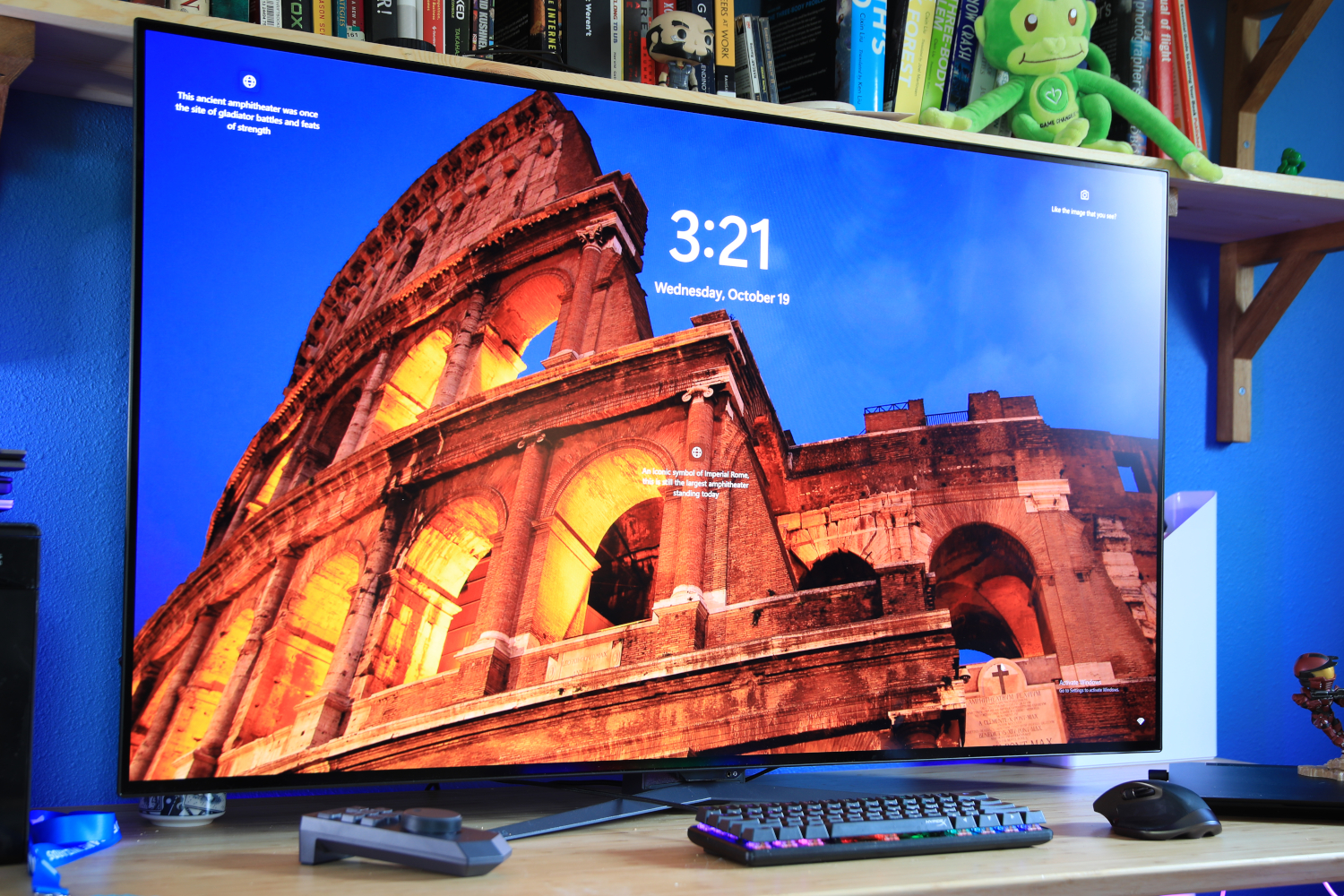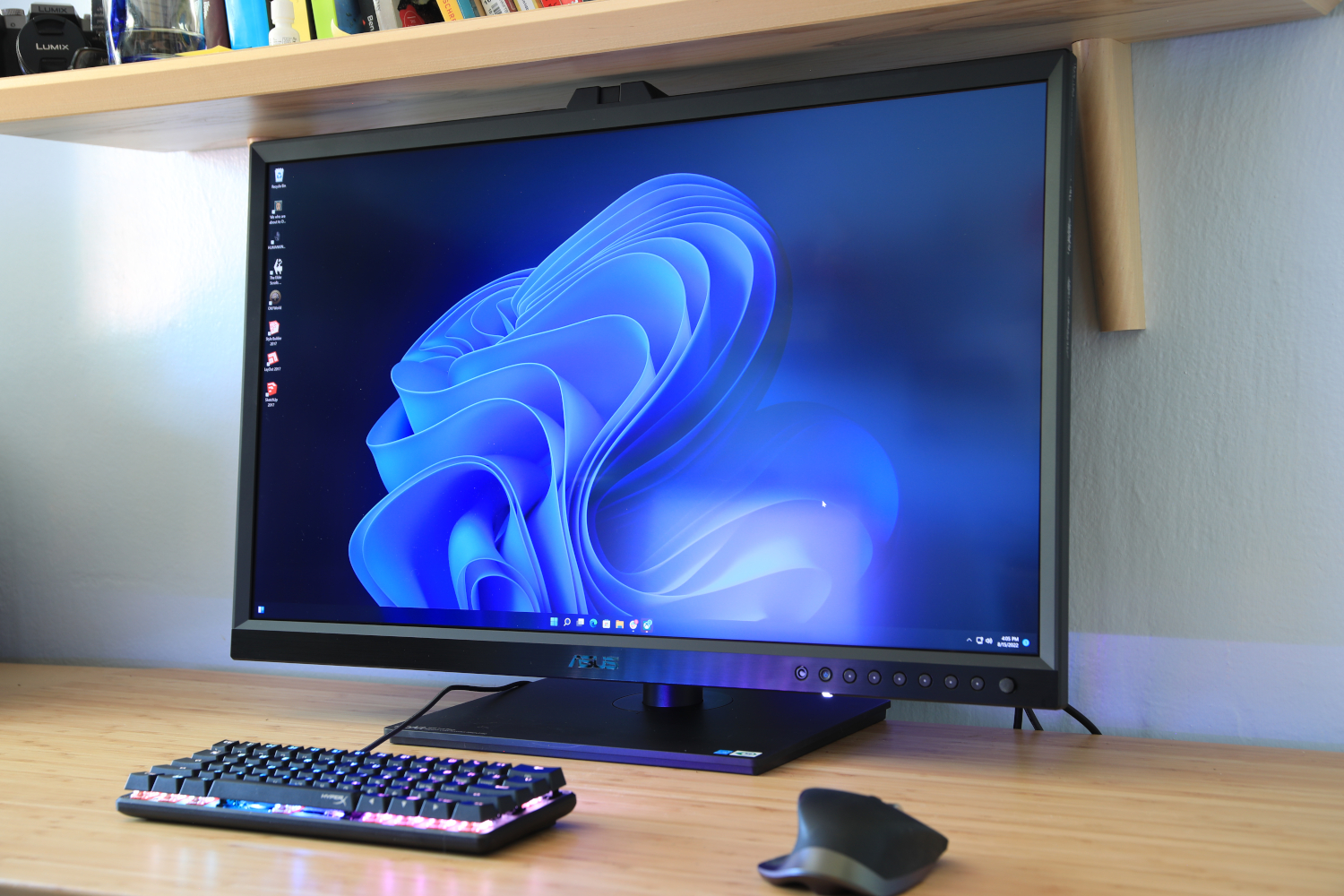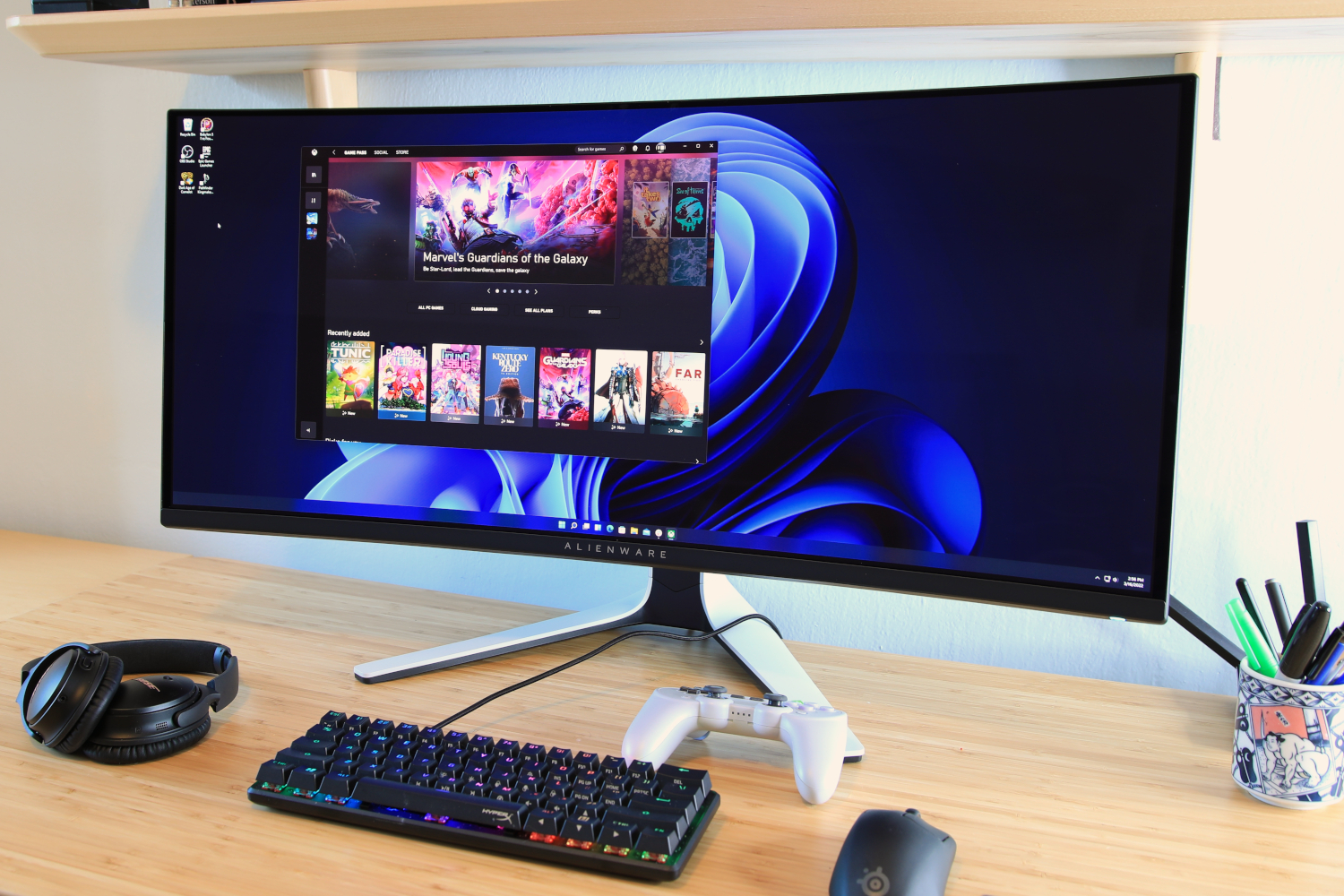Expert's Rating
Pros
- Excellent SDR, strong HDR image
- Great motion clarity
- Superior contrast and wide color gamut
- Multiple PC-friendly connections including USB-C hub
- Useful bundled remote
Cons
- Only one HDMI 2.1 input
- Sharpness is just ok
- Stand offers no adjustment, no VESA mount
Our Verdict
Acer’s Predator CG48 delivers a beautiful 48-inch OLED screen and tons of PC-friendly features, though it’s more similar to its LG competitor than it is different. When full price, the Acer has a slight edge due to its USB-C power capabilities, but ultimately it’s best to go for whichever is on sale for the lowest price.
Best Prices Today: Acer Predator CG48
PC gamers looking for a big screen monitor have great options in 2022, including new 42-inch and 48-inch monitors with OLED panels. These have many benefits over the IPS and VA panel monitors that came before them, but also sell at a higher price. The Predator CG48 proves the premium is worth paying. It’s rather similar to LG’s alternative, though, so price may become the deciding factor.
Note: This review is part of our ongoing roundup of the best monitors. Go there to learn about competing products, what to look for in a monitor, and buying recommendations.
Acer Predator CG48: The specs
The Acer Predator CG48 is a 48-inch 4K monitor with an OLED panel. While Acer doesn’t detail the panel used by the monitor, it’s probably the same LG-produced OLED panel found in the LG Ultragear 48GQ900-B.
- Display size: 48-inch, 16:9 aspect ratio
- Native resolution: 3480×2160
- Panel type: OLED
- Refresh rate: 138Hz
- HDR: Yes, HDR10
- Adaptive sync: AMD FreeSync Premium Pro
- Ports: 1x HDMI 2.1, 3x HDMI 2.0, 1x DisplayPort 1.4, 1x USB-C with DisplayPort Alternate Mode and 65 watts Power Delivery, 1x 3.5mm audio out, 4x USB-A
- Stand adjustment: None
- VESA mount: Yes, 200x200mm TV wall mount
- Speakers: 2x 10-watt stereo speakers
- Price: $1,499.99 MSRP
Despite its TV-like size, the Predator CG48 is a monitor, not a television. It lacks a TV tuner and can’t be connected to a coaxial input. It also lacks the smart features found on many modern TVs such as built-in apps and a processor capable of smoothing jerky motion (like that of 24 FPS movies). The CG48 makes up for this with numerous PC-friendly connection options including DisplayPort and USB-C.
Acer Predator CG48: Design
The Acer Predator CG48 is a 48-inch monitor meant as an alternative to buying a television, such as LG’s 48-inch C1 or C2 OLED. This comes across in its design, which is similar to most OLED TVs.
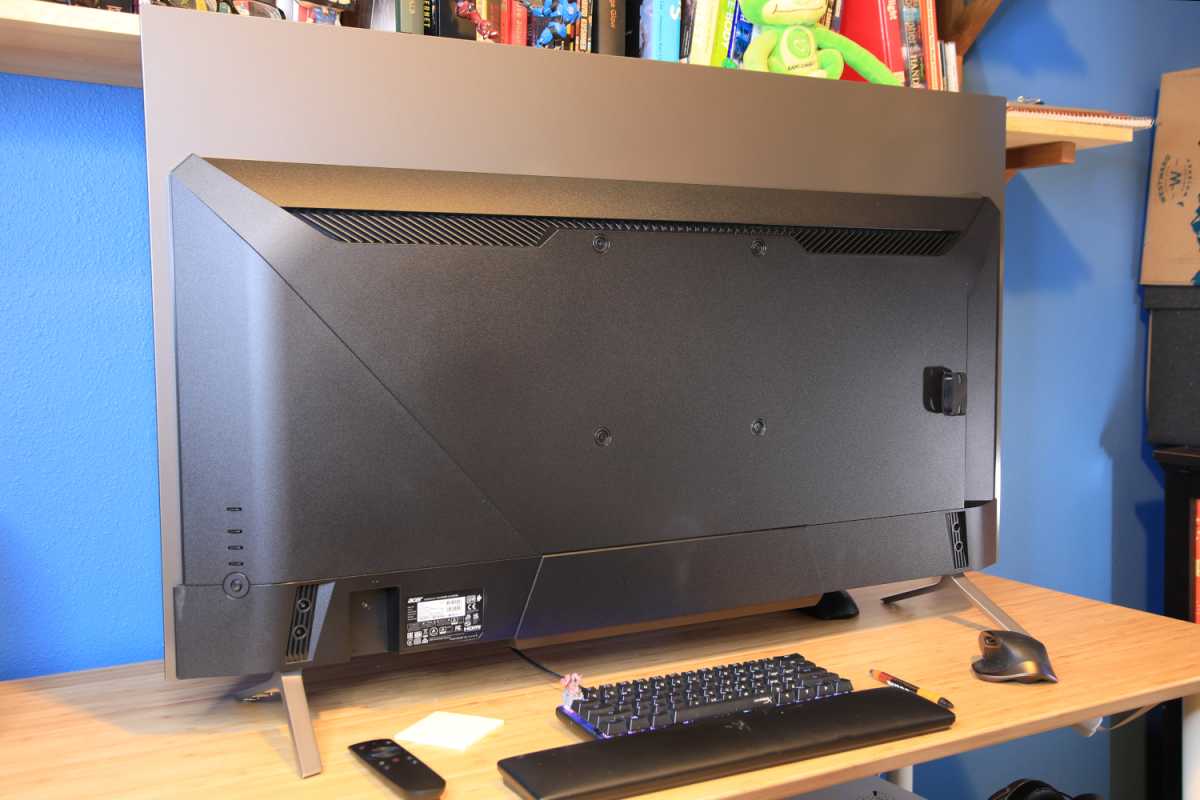
Matt Smith
It starts with the profile, which consists of a super-slim panel attached to a bulkier low half that contains the monitor’s brains and ports. The result is a simple silhouette that’s virtually identical to the LG Ultragear 48GQ900-B, LG C2 OLED, and Sony Bravia XR A90K. All of these displays are about 1.5-inches thick at their thickest point. There are differences in materials, as Acer opts for silvers and grays instead of the black and charcoal of competitors—but this is only obvious from the rear, which most owners will only see when unboxing the display.
The main functional difference is the stand. Acer opts for a pair of legs, at either end of the display panel. It’s a simple, stable design, but also requires a desk or TV stand that’s nearly as wide as the 48-inch monitor. LG’s Ultragrear 48GQ900-B instead uses a wedge-shaped stand, more like a traditional monitor, making it easier to position on a small surface. This is a small win for LG. Neither of these displays offer height, tilt, or swivel adjustment.
Wall mounting is an option, and will work better than some other large-screen monitors. The Acer’s ports face to the side, not the rear, which is far easier to work with when trying to mount the display flush with a wall.
Acer Predator CG48: Features and menus

The Acer Predator CG48 comes with plenty of HDMI ports and a convenient USB-C port for power.
Matt Smith
The Acer Predator CG48 ships with four HDMI ports, plus DisplayPort and a USB-C port with DisplayPort Alternate Mode. That’s a total of six video inputs, which is the most of any comparable monitor I’ve tested.
Just one of the four HDMI ports supports HDMI 2.1: the rest only support HDMI 2.0. That’s a limitation for gamers who own both an Xbox Series X and PlayStation 5. One of the two consoles will have to connect over HDMI 2.0 and, in so doing, lose out on 4K at 120Hz (though you can use an HDMI switcher, of course).
The monitor’s USB-C port supports both DisplayPort Alternate Mode and up to 65 watts of USB Power Delivery, meaning it can charge a connected device. It also functions as a USB-C hub which connects to four downstream USB 3.2 ports.
A 3.5mm audio output can send audio to a soundbar or home theater system. It works fine, but the LG Ultragear 48GQ900-B also has optical audio, which is a higher-quality connection. This is an important point if you want to use the monitor with high-end home theater audio.
A bundled remote is included with the Predator CG48 and controls the on-screen menu (controls are also found on the monitor, but the remote is more convenient). Unlike LG’s Ultragear 48Q900-B, which has an odd remote built around a big dial, the Predator CG48’s remote is slim and built around a circle that navigates up, down, left, or right, with a big “OK” button in the middle. This is similar to most TV and streaming box remotes and feels more approachable.
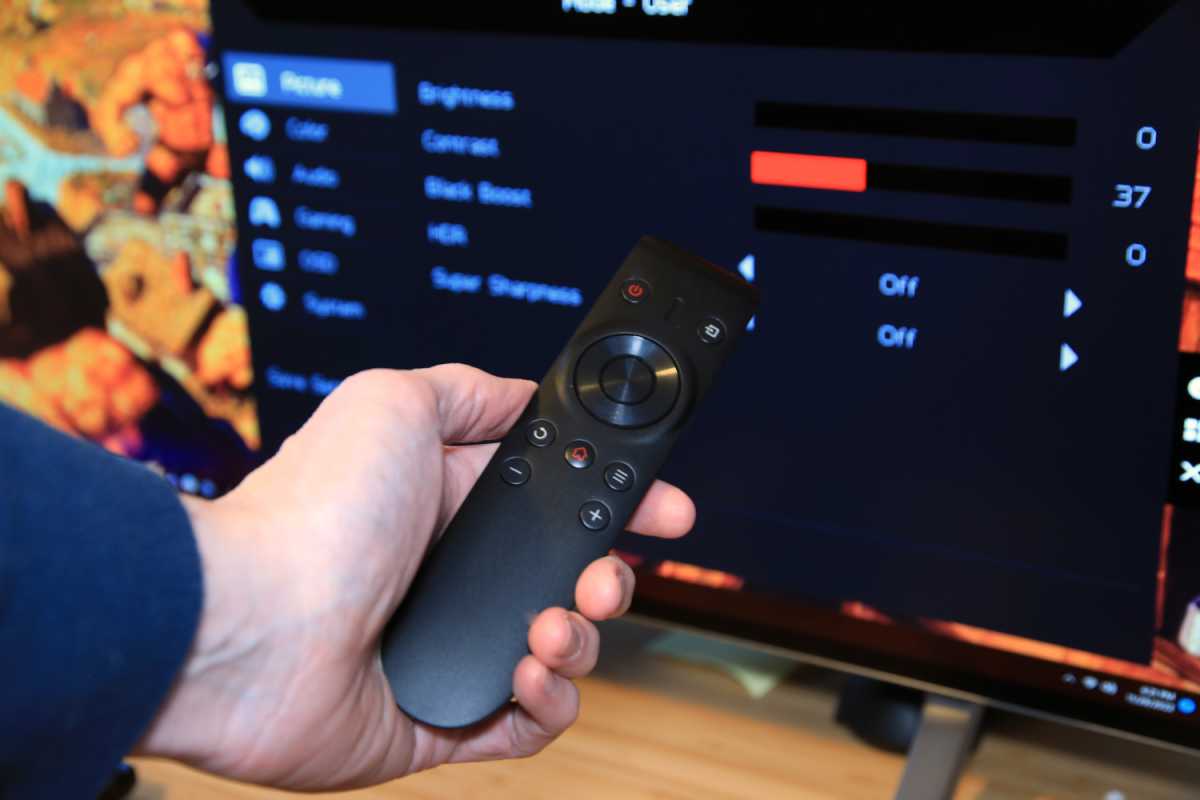
The Acer Predator CG48 has a well thought-out menu and a handy remote.
Matt Smith
The menus are intuitive—for PC enthusiasts. Acer uses the same menu system it does for any other monitor. It’s not as slick as that used by Dell, and the font size is on the small side, but options are clearly labeled and easy to navigate with the remote. In fact, the remote makes the menu much easier to use than most monitors. There’s no need to awkwardly lean forward and fiddle with buttons.
I did notice a few quirks. The display lacks a factory reset option, which is strange. HDR was not set to automatic out-of-the-box, so HDR content won’t look its best until that setting is turned on. And the “standard” color gamut, although very wide and accurate, looks particularly oversaturated and a bit too yellow with some SDR content. Fortunately, the monitor has many other color modes, including an sRGB mode, plus six-axis color customization.
A pair of 10-watt speakers round out the options. They provide acceptable audio in less complex situations: the beeps and boops of Vampire Survivors were crisp. Content with a more complex soundscape, like music, action films, or open-world games such as Cyberpunk 2077, can overwhelm the speakers and muddy the presentation. Maximum volume is lackluster, too, so the speakers are only suitable for a small room.
Acer Predator CG48: SDR image quality
The Acer Predator CG48 is a big OLED monitor with 4K resolution and a wide color gamut. These traits lead to performance that, while not perfect in every category, is sure to impress most people.

Matt Smith
Maximum full-screen SDR brightness comes in at 213 nits. This is higher than the LG Ultragear 48GQ900-B, which limited SDR brightness to just 143 nits.
The Predator’s CG48’s brightness is still low when compared to more conventional monitors, and way, way lower than the Asus ProArt PA32DC, a high-end 32-inch OLED monitor. However, I found the brightness more than adequate in use.
The Acer also benefits from an effective anti-glare coating that helps keep the display usable in bright rooms. It works well in most situations, though a strong light source (like a sunlit window) will still cause problems.
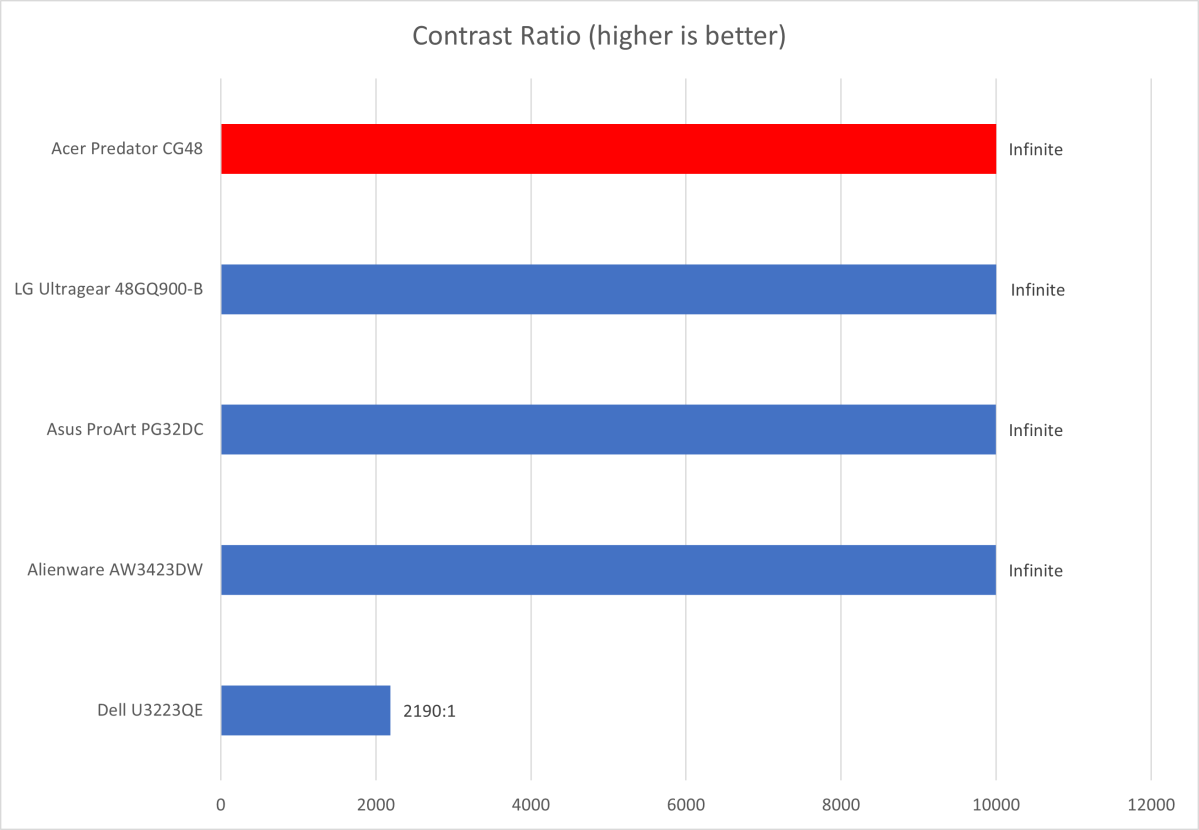
Matt Smith
Contrast ratio is where OLED stands out, and the Acer Predator CG48 is no exception. OLED can control each pixel individually and even turn a pixel off entirely when required, providing a truly abyssal black level in dark scenes. It also doesn’t suffer from bloom, a problem that can cause a bright halo around small objects on a Mini-LED or edge-lit LED monitor with dimming zones.
The contrast ratio of the OLED monitors I’ve tested is effectively infinite, since they can all achieve a luminance reading of zero nits. None of them obviously outperform or overperform their competitors in this metric, but all of them beat an IPS monitor. The difference is obvious, especially when using a monitor in a dark room.

Matt Smith
The Acer Predator CG48 has a wide color gamut that covers more than 100 percent of sRGB, 98 percent of DCI-P3, and 89 percent of Adobe RGB. This is identical to the performance of LG’s Ultragear 48GQ900-B and a bit better than Alienware’s ultrawide AW3423DW. Asus’ ProArt PG32DC leaps ahead, as it covers an impressive 98 percent of Adobe RGB.
In real-world use, the Predator CG48’s color gamut is plenty wide to do content justice. It can handle a wide variety of content creation including graphics design, video editing, and photo editing, and it will look highly saturated and vivid in movies and games.
[color accuracy]
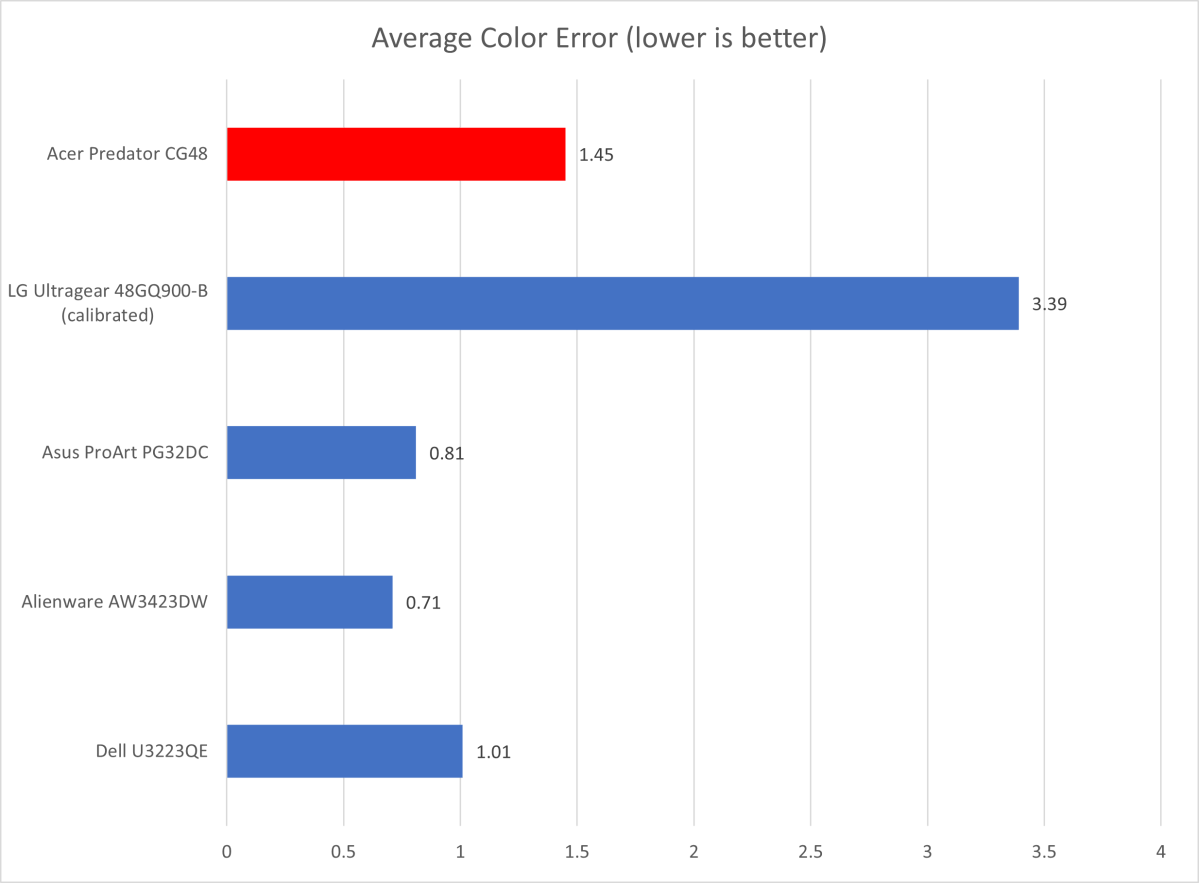
Matt Smith
Color accuracy is good, as well, beating the LG Ultragear 48GQ900-B, which had issues with color accuracy at default settings. The Acer can’t beat either the Asus ProArt PG32DC or Alienware AW3423DW, but the gap is small enough that it won’t be obvious in use. The Predator CG48’s color looks realistic and convincing out of the box.
The Predator CG48 scored well in color temperature with a default reading of 6400K, barely off the target of 6500K. This provides a warm, inviting image, and is a big improvement over the LG Ultragear 48GQ900-B, which was way off target at 10200K out of the box (and 7100K after some tweaks). My testing also turned up a gamma result of 2.1, which is near the target of 2.2. This means content looks roughly as bright as intended.
Sharpness is a problem for the Predator CG48. 4K resolution on a 48-inch screen works out to about 91 pixels per inch—about the same as a 24-inch 1080p monitor. To make matters worse, this monitor doesn’t appear to use an RGB pixel arrangement (a common issue among affordable OLED monitors), which leads to problems around fine fonts and interface elements. I saw “fringing” around fonts, an issue where the font appears to have a shadow or border that shouldn’t be visible. The LG Ultragear 48GQ900-B and Alienware AW3423DW both share this issue, while the expensive Asus ProArt PG32DC avoids it.
Despite this, the Acer Predator CG48’s SDR image quality is great overall. It’s suited for PC gaming, streaming video, and high-quality 4K movies, all of which play to the strengths of its contrast and color while avoiding issues with sharpness and brightness. And it looks even better with HDR turned on.
Acer Predator CG48: HDR image quality
The Acer Predator CG48 claims a maximum HDR brightness of up to 900 nits, but it’s not VESA DisplayHDR certified. My testing showed that its full-screen HDR brightness was 228 nits, barely higher than the SDR result of 213 nits. Testing in a 10 percent window (that is, with only 10 percent of the display lit) didn’t change this result. It does appear that the display achieves a much higher brightness when a slim fraction of the display is lit, as might be seen when displaying stars in a night sky, but I’m unable to test the brightness of details this small.
Despite this, the Predator CG48 provided a convincing HDR experience when used in a dark room. Its brightness is nowhere near that of Mini-LED, but still bright enough to pack a punch in a home theater. This is less true when using the monitor on a desk in a well-lit home office, however.
The HDR experience is supported by its superior contrast ratio and wide color gamut. These strengths provide a wide range of luminance to work with and plenty of colors to appear vivid.
Lumiance stability is decent in HDR. Some OLED displays, such as the Alienware AW3423DW, have problems with the overall display brightness swinging noticeably when minimizing or maximizing windows. The Predator CG48, like the LG Ultragear 48GQ900-B, shows a hint of flicker in the most extreme situations, such as opening a Word document on a desktop with a dark background, but it’s barely noticeable. I’d prefer that it not be visible at all, but this is the reality of current OLED panel technology. Even the high-end Asus ProArt PA32DC has this issue.
The Acer Predator CG48, like the LG48GQ900-B, only supports the HDR10 standard and not other HDR standards, such as Dolby Vision. That’s fine if you intend to use the monitor with a computer, because nearly all HDR content shown on a computer will be intended to be viewed in HDR10. Dolby Vision is more relevant if you like to stream shows from major streaming platforms or remain devoted to 4K Blu-ray discs.
Overall, the Acer Predator CG48’s HDR performance is good. It leans more heavily on its contrast ratio and color performance than its brightness, which means it will never hit the eye-searing heights of a Mini-LED alternative like the Samsung Odyssey Neo G9. But it does provide shadow detail, brilliant highlights in dark scenes, and vivid color. It’s best for use in a dark room, as this will make its lack of full-screen brightness harder to notice.
Acer Predator CG48: Motion clarity
The Acer Predator CG48 has a maximum refresh rate of up to 138Hz and supports AMD FreeSync Premium Pro. The LG Ultragear 48GQ900-B has both of these features, plus official G-sync support, giving LG a slight edge here.
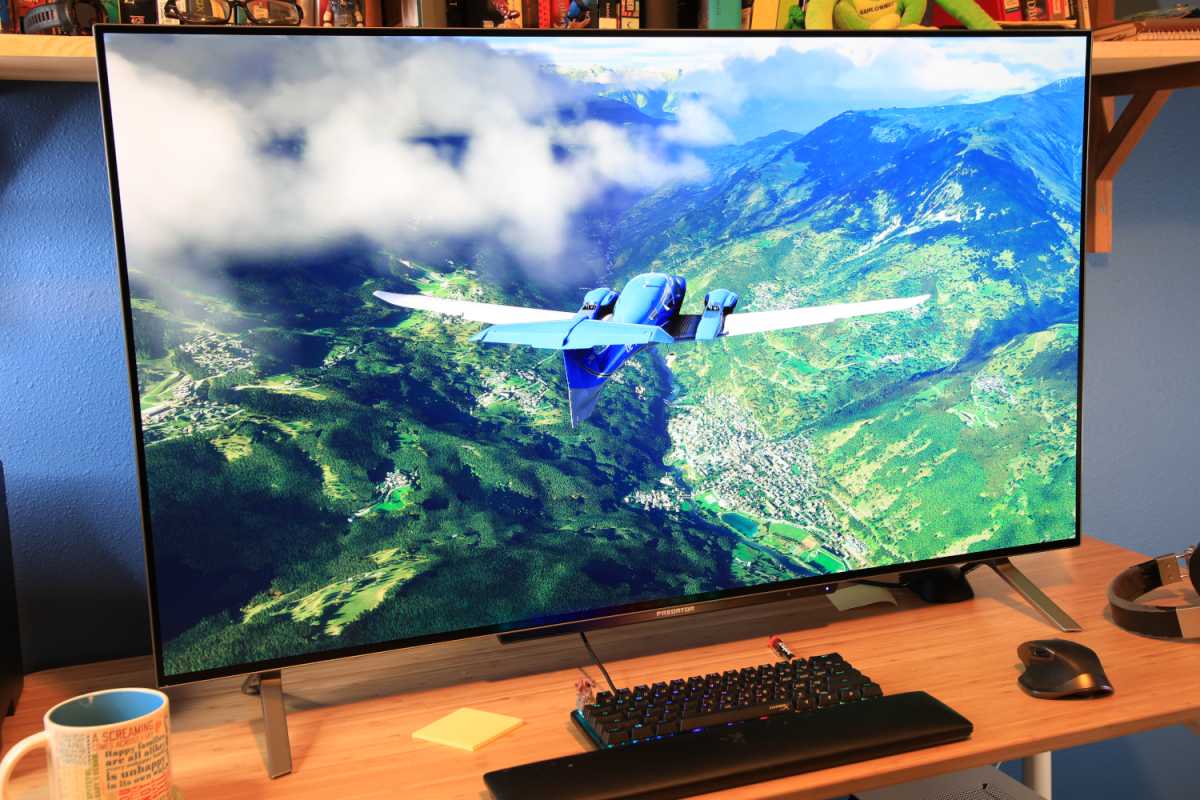
The Acer Predator CG48’s motion clarity is more than suitable for games such as Flight Simulator or even faster paced e-sports titles.
Matt Smith
Motion clarity is excellent. A refresh rate of 138Hz is nowhere near the highest available today, but it’s high enough to provide a wonderful sense of fluidity and plenty of detail. Small objects are visible when moving quickly across the screen and fast camera pans preserve enough detail to know what you’re looking at. Very fine elements, like small fonts showing a character’s name in League of Legends, remain hard to read—for that level of motion clarity you’d need a 240Hz or 360Hz refresh rate, which is not available in an OLED monitor (yet).
It helps that OLED monitors have very low pixel response times. This means a pixel’s color can change quickly, further aiding in motion clarity. The benefit of this is improved motion clarity even at lower refresh rates, such as 60Hz.
The lack of HDMI 2.1 support for all HDMI ports is a limitation, since it means not all HDMI ports can make full use of the enhanced refresh rate (HDMI 2.0 tops out at 4K/60FPS in most situations).
Still, this doesn’t spoil the Predator CG48’s excellent motion performance. This is a clear, crisp monitor that looks great when displaying games and feels fluid in everyday use. The LG Ultragear 48GQ900-B can match it, but not exceed it, and competitive monitors with IPS or VA panel technology can’t compare.
Should you buy an Acer Predator CG48?
The Acer Predator CG48 is a great 48-inch OLED monitor and a good choice for anyone looking to go big with their next monitor. It has excellent color performance, a wide range of connectivity, and a handy remote.
Compared to the LG 48GQ900-B, the most obvious alternative, the Predator CG48 feels better suited to PC use and less suited to use with game consoles. The Acer only has one HDMI 2.1 port, compared to the LG’s three. But the Acer has USB-C with Power Delivery, which the LG lacks, and has more video connections overall. The Predator CG48’s on-screen menu options and layout are a better fit for PC use than those of the LG, which has fewer options and relies on a larger, more awkward remote.
Pricing and availability is the wildcard. The Acer Predator CG48 and LG 48GQ900-B both retail at an MSRP of $1,499.99. However, the LG 48GQ900-B dipped as low as $849.99 during Black Friday sales and was typically $1,199.99 prior to that. Acer’s monitor is still listed at MSRP.
At sale prices, the LG is the obvious pick. The two monitors are more similar than they are different, so it makes sense to pick the less expensive option. If the two happen to be similarly priced when buying, though, the Acer is the better choice overall.




